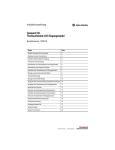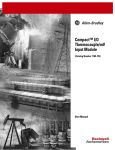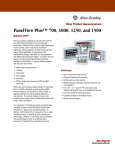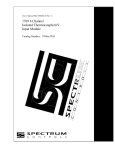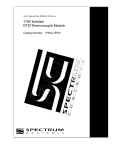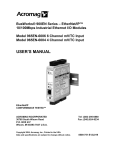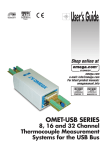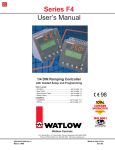Download 1769-IN026C-EN-P, Compact I/O Thermocouple/mV Input Module
Transcript
Installation Instructions Compact I/O Thermocouple/mV Input Module Catalog Number 1769-IT6 Topic Page Important User Information 2 Hazardous Location Considerations 3 Preventing Electrostatic Discharge 4 Removing Power 4 About the Thermocouple/mV Input Module 5 About the Compact I/O System 5 Install the Thermocouple/mV Input Module 7 Mount Expansion I/O 8 Mount the Module to a Panel 9 Mount the Module to a DIN Rail 10 Replace a Single Module within a System 10 Wire the Thermocouple/mV Input Module 11 Label the Terminals 12 Remove the Finger-safe Terminal Block 12 Wire the Finger-safe Terminal Block 13 Ground the Thermocouple/mV Input Module 15 Cold-junction Compensation (CJC) 16 I/O Memory Mapping 17 Configuration Data File 18 Specifications 20 Additional Resources 24 2 Compact I/O Thermocouple/mV Input Module Important User Information Solid state equipment has operational characteristics differing from those of electromechanical equipment. Safety Guidelines for the Application, Installation and Maintenance of Solid State Controls (publication SGI-1.1 available from your local Rockwell Automation sales office or online at http://www.rockwellautomation.com/literature) describes some important differences between solid state equipment and hard-wired electromechanical devices. Because of this difference, and also because of the wide variety of uses for solid state equipment, all persons responsible for applying this equipment must satisfy themselves that each intended application of this equipment is acceptable. In no event will Rockwell Automation, Inc. be responsible or liable for indirect or consequential damages resulting from the use or application of this equipment. The examples and diagrams in this manual are included solely for illustrative purposes. Because of the many variables and requirements associated with any particular installation, Rockwell Automation, Inc. cannot assume responsibility or liability for actual use based on the examples and diagrams. No patent liability is assumed by Rockwell Automation, Inc. with respect to use of information, circuits, equipment, or software described in this manual. Reproduction of the contents of this manual, in whole or in part, without written permission of Rockwell Automation, Inc., is prohibited. Throughout this manual, when necessary, we use notes to make you aware of safety considerations. WARNING IMPORTANT ATTENTION Identifies information about practices or circumstances that can cause an explosion in a hazardous environment, which may lead to personal injury or death, property damage, or economic loss. Identifies information that is critical for successful application and understanding of the product. Identifies information about practices or circumstances that can lead to personal injury or death, property damage, or economic loss. Attentions help you identify a hazard, avoid a hazard and recognize the consequences. SHOCK HAZARD Labels may be on or inside the equipment, for example, a drive or motor, to alert people that dangerous voltage may be present. BURN HAZARD Labels may be on or inside the equipment, for example, a drive or motor, to alert people that surfaces may reach dangerous temperatures. Publication 1769-IN026C-EN-P - February 2010 Compact I/O Thermocouple/mV Input Module 3 Hazardous Location Considerations This equipment is suitable for use in Class I, Division 2, Groups A, B, C, D or nonhazardous locations only. This Warning statement applies to use in hazardous locations. WARNING Explosion Hazard • Substitution of components may impair suitability for Class I, Division 2. • Do not replace components or disconnect equipment unless power has been switched off or the area is known to be nonhazardous. • Do not connect or disconnect components unless power has been switched off or the area is known to be nonhazardous. • This product must be installed in an enclosure. • All wiring must comply with N.E.C. article 501-4(b). Environnements dangereux Cet équipement est conçu pour être utilisé dans des environnements de Classe 1, Division 2, Groupes A, B, C, D ou non dangereux. La mise en garde suivante s’applique à une utilisation dans des environnements dangereux. AVERTISSEMENT DANGER D’EXPLOSION • La substitution de composants peut rendre cet équipement impropre à une utilisation en environnement de Classe 1, Division 2. • Ne pas remplacer de composants ou déconnecter l'équipement sans s'être assuré que l'alimentation est coupée et que l'environnement est classé non dangereux. • Ne pas connecter ou déconnecter des composants sans s'être assuré que l'alimentation est coupée ou que l'environnement est classé non dangereux. • Ce produit doit être installé dans une armoire. Publication 1769-IN026C-EN-P - February 2010 4 Compact I/O Thermocouple/mV Input Module Preventing Electrostatic Discharge ATTENTION Electrostatic discharge can damage integrated circuits or semiconductors if you touch bus connector pins or the terminal block. Follow these guidelines when you handle the module: • • • • • • Touch a grounded object to discharge static potential. Wear an approved wrist-strap grounding device. Do not touch the bus connector or connector pins. Do not touch circuit components inside the module. Use a static-safe work station, if available. Keep the module in its static-shield box when not in use. Removing Power ATTENTION Remove power before removing or inserting this module. When you remove or insert a module with power applied, an electrical arc may occur. An electrical arc can cause personal injury or property damage by: • sending an erroneous signal to your system’s field devices, causing unintended machine motion. • causing an explosion in a hazardous environment. Electrical arcing causes excessive wear to contacts on both the module and its mating connector. Worn contacts may create electrical resistance. Publication 1769-IN026C-EN-P - February 2010 Compact I/O Thermocouple/mV Input Module 5 About the Thermocouple/mV Input Module The thermocouple/mV module receives and stores digitally-converted thermocouple and/or millivolt analog data from any combination of as many as six thermocouple or millivolt analog sensors. Each input channel is individually configurable via software for a specific input device and provides open-circuit, over-range, and under-range detection and indication. The module receives all of its +5V DC and +24V DC power from the 1769 Compact bus. The module contains a removable terminal block with two cold-junction compensation (CJC) sensors. Accepted Inputs Range Thermocouple Type J -210…1200 °C (-346…2192 °F) Thermocouple Type K -270…1370 °C (-454…2498 °F) Thermocouple Type T -270…400 °C (-454…752 °F) Thermocouple Type E -270…1000 °C (-454…1832 °F) Thermocouple Type R 0…1768 °C (32…3214 °F) Thermocouple Type S 0…1768 °C (32…3214 °F) Thermocouple Type B 300…1820 °C (572…3308 °F) Thermocouple Type N -210…1300 °C (-346…2372 °F) Thermocouple Type C 0…2315 °C (32…4199 °F) CJC sensors 0…85 °C (32…185 °F) Millivolt inputs -50…50 mV -100…100 mV About the Compact I/O System Compact I/O modules are suitable for use in an industrial environment when installed in accordance with these instructions. Specifically, this equipment is intended for use in clean, dry environments (Pollution Degree 2(1)) and to circuits not exceeding Over Voltage Category II(2) (IEC 60664-1).(3) (1) (2) (3) Pollution Degree 2 is an environment where, normally, only nonconductive pollution occurs except that occasionally a temporary conductivity caused by condensation shall be expected. Over Voltage Category II is the load level section of the electrical distribution system. At this level, transient voltages are controlled and do not exceed the impulse voltage capability of the product’s insulation. Pollution Degree 2 and Over Voltage Category II are International Electrotechnical Commission (IEC) designations. Publication 1769-IN026C-EN-P - February 2010 6 Compact I/O Thermocouple/mV Input Module Module Description 1 2a Item Description 1 Bus lever (with locking function) 2a Upper-panel mounting tab 2b Lower-panel mounting tab 3 Module status indicator 4 Module door with terminal identification label 5a Movable bus connector with female pins 5b Stationary bus connector with male pins 6 Nameplate label 7a Upper tongue-and-groove slots 7b Lower tongue-and-groove slots 8a Upper DIN-rail latch 8b Lower DIN-rail latch 9 Write-on label (user ID tag) 10 Removable terminal block (RTB) with finger-safe cover 10a RTB upper-retaining screw 10b RTB lower-retaining screw 11 CJC sensors 3 OK Thermocouple/mV DANGER Do Not Remove RTB Under Power Unless Area is Non-Hazardous 10a NC CJC 0+ 11 IN 0+ CJC 0IN 3+ IN 0IN 1+ IN 3IN 1- 10 IN 4+ IN 4- 11 IN 2+ IN 2- IN 5+ IN 5- 10b CJC 1CJC 1+ NC Ensure Adjacent Bus Lever is Unlatched/Latched Before/After Removing/Inserting Module 4 1769-IT6 8a 7a 7a 2b OK Thermocouple/mV 5a 5b 9 6 7b 7b 8b Publication 1769-IN026C-EN-P - February 2010 Compact I/O Thermocouple/mV Input Module 7 Install the Thermocouple/mV Input Module The module can be attached to the controller or an adjacent I/O module before or after mounting. For mounting instructions, see Mount the Module to a Panel on page 9, or Mount the Module to a DIN Rail on page 10. To work with a system that is already mounted, see Replace a Single Module within a System on page 10. IMPORTANT To reduce the effects of electrical noise, install the 1769-IT6 module at least two slots away from Compact I/O 120/240V AC power supplies. This procedure explains how to assemble the Compact I/O system. 3 4 2 1 6 1 5 1. Disconnect power. 2. Check that the bus lever of the module to be installed is in the unlocked (fully right) position. 3. Use the upper and lower tongue-and-groove slots (1) to secure the modules together (or to a controller). 4. Move the module back along the tongue-and-groove slots until the bus connectors (2) line up with each other. 5. Use your fingers or a small screwdriver to push the bus lever back slightly to clear the positioning tab (3). Publication 1769-IN026C-EN-P - February 2010 8 Compact I/O Thermocouple/mV Input Module 6. To allow communication between the controller and module, move the bus lever fully to the left (4) until it clicks, making sure it is locked firmly in place. ATTENTION When attaching I/O modules, it is very important that the bus connectors are securely locked together to be sure of proper electrical connection. 7. Attach an end-cap terminator (5) to the last module in the system by using the tongue-and-groove slots as before. 8. Lock the end-cap bus terminator (6). IMPORTANT A 1769-ECR or 1769-ECL right or left end cap (respectively) must be used to terminate the end of the communication bus. Mount Expansion I/O ATTENTION During panel or DIN-rail mounting of all devices, be sure that all debris (metal chips, wire strands, and so forth) is kept from falling into the module. Debris that falls into the module could cause damage on powerup. Minimum Spacing Bottom Publication 1769-IN026C-EN-P - February 2010 End Cap Compact I/O Compact I/O Compact I/O Host Controller Side Compact I/O Top Compact I/O Maintain spacing from enclosure walls, wireways, adjacent equipment, and so forth. Allow 50 mm (2 in.) of space on all sides for adequate ventilation. Side Compact I/O Thermocouple/mV Input Module 9 Mount the Module to a Panel Mount the module to a panel by using two screws per module. Use M4 or #8 panhead screws. Mounting screws are required on every module. Mount the Module to a Panel by Using the Dimensional Template For more than 2 modules: (number of modules-1) x 35 mm (1.38 in.). End Cap Compact I/O 122.6 ±0.2 (4.826 ±0.008) Compact I/O All dimensions are in mm (in.). Hole spacing tolerance: ±0.4 mm (0.016 in.). 28.5 (1.12) 35 (1.38) Compact I/O 132 (5.197) Host Controller Refer to host controller documentation for this dimension. Mount the Module to a Panel by Using Modules as a Template This procedure uses the assembled modules as a template for drilling holes in the panel. If you have sophisticated panel-mounting equipment, you can use the dimensional template above. Due to module-mounting hole tolerance, it is important to follow these procedures. 1. On a clean work surface, assemble no more than three modules. 2. Using the assembled modules as a template, carefully mark the center of all module-mounting holes on the panel. 3. Return the assembled modules to the clean work surface, including any previously mounted modules. 4. Drill and tap the mounting holes for the recommended M4 or #8 screw. 5. Place the modules back on the panel and check for proper hole alignment. 6. Attach the modules to the panel by using the mounting screws. TIP If you are mounting more modules, mount only the last one of this group and put the others aside. This reduces remounting time during drilling and tapping of the next group. 7. Repeat these steps for any remaining modules. Publication 1769-IN026C-EN-P - February 2010 10 Compact I/O Thermocouple/mV Input Module Mount the Module to a DIN Rail The module can be mounted by using these DIN rails: 35 x 7.5 mm (EN 50 022 - 35 x 7.5) or 35 x 15 mm (EN 50 022 - 35 x 15). Before mounting the module on a DIN rail, close the DIN rail latches. Press the DIN rail mounting area of the module against the DIN rail. The latches will momentarily open and lock into place. Replace a Single Module within a System Follow these steps to replace the module while the system is mounted to a panel or DIN rail. 1. Remove power. ATTENTION Remove power before removing or inserting this module. When you remove or insert a module with power applied, an electrical arc may occur. An electrical arc can cause personal injury or property damage by: • sending an erroneous signal to your system’s field devices, causing unintended machine motion. • causing an explosion in a hazardous environment. Electrical arcing causes excessive wear to contacts on both the module and its mating connector. Worn contacts may create electrical resistance. 2. On the module to be removed, remove the upper and lower mounting screws from the module (or open the DIN rail latches with a screwdriver). 3. Move the bus lever to the right to disconnect (unlock) the bus. 4. On the right-side adjacent module, move its bus lever to the right (unlock) to disconnect it from the module to be removed. 5. Gently slide the disconnected module forward. If you feel excessive resistance, check that the module has been disconnected from the bus and that both mounting screws have been removed (or DIN rail latches opened). TIP You may need to rock the module slightly from front to back to remove it, or, in a panel-mounted system, loosen the screws of adjacent modules. Publication 1769-IN026C-EN-P - February 2010 Compact I/O Thermocouple/mV Input Module 11 6. Before installing the replacement module, be sure that the bus levers on the module to be installed and on the right-side adjacent module are in the unlocked (fully right) position. 7. Slide the replacement module into the open slot. 8. Connect the modules by locking (fully left) the bus levers on the replacement module and the right-side adjacent module. 9. Replace the mounting screws (or snap the module onto the DIN rail). Wire the Thermocouple/mV Input Module ATTENTION The possibility exists that grounded or exposed thermocouples can become shorted to a potential greater than that of the thermocouple. Due to possible shock hazard, take care when wiring these types of thermocouples. Consider these system wiring guidelines when wiring your system: • Do not use the module’s NC terminals as connection points. • Do not tamper with or remove the CJC sensors on the terminal block. Removal of one or both sensors will reduce accuracy and set the open-circuit bit for that CJC sensor. • For thermocouple inputs, always use shielded, twisted-pair thermocouple extension lead wires specified by the thermocouple manufacturer for the thermocouple type you are using. Using the incorrect thermocouple extension wire type or not following correct polarity convention will cause invalid readings. • Keep the cable shield connection to ground as short as possible. • To limit noise, keep thermocouple and millivolt signal wires as far away as possible from power and load lines as well as other sources of electrical noise, such as motors, transformers, contactors, and AC devices. • If the field wiring must cross AC or power cables, be sure that they cross at right angles. • For millivolt inputs, always use Belden 8761 (shielded, twisted-pair) or equivalent wire to be sure of proper operation and high immunity to electrical noise. • If multiple power supplies are used with millivolt analog inputs, the power supply commons must be connected. Publication 1769-IN026C-EN-P - February 2010 12 Compact I/O Thermocouple/mV Input Module • Ground the shield drain wire at only one end. The typical location is the same point as the sensor ground reference. – For grounded thermocouples or millivolt sensors, this is at the sensor end. – For insulated/ungrounded thermocouples, this is at the module end. Contact your sensor manufacturer for additional details. • If it is necessary to connect the shield drain at the module end, connect it to earth ground by using a panel or DIN-rail mounting screw. • Routing the field wiring in a grounded conduit can further reduce electrical noise. Label the Terminals A removable, write-on label is provided with the module. Remove the label from the door, mark your unique identification of each terminal with permanent ink, and slide the label back into the door. Your markings (ID tag) will be visible when the module door is closed. Remove the Finger-safe Terminal Block To remove the terminal block, loosen the upper and lower retaining screws. The terminal block will back away from the module as you remove the screws. When replacing the terminal block, torque the retaining screws to 0.46 N•m (4.1 lb•in). Upper Retaining Screw Lower Retaining Screw Publication 1769-IN026C-EN-P - February 2010 Compact I/O Thermocouple/mV Input Module 13 Wire the Finger-safe Terminal Block When wiring the terminal block, keep the finger-safe cover in place. 1. Loosen the terminal screws to be wired. 2. Route the wire under the terminal pressure plate. You can use the bare wire or a spade lug. The terminals accept a 6.35 mm (0.25 in.) spade lug. TIP The terminal screws are non-captive. Therefore, it is possible to use a ring lug (1/4 in. maximum o.d. with a 0.139 in. minimum i.d. (M3.5)) with the module. 3. Tighten the terminal screw, making sure the pressure plate secures the wire. Recommended torque when tightening terminal screws is 0.68 N•m (6 lb•in). TIP If you need to remove the finger-safe cover, insert a screwdriver into one of the square wiring holes and gently pry the cover off. If you wire the terminal block with the finger-safe cover removed, you will not be able to put it back on the terminal block because the wires will be in the way. If you remove the terminal block from the module, use the write-on label on the side of the terminal block to identify the module location and type. SLOT # _____ MODULE TYPE ______ Wire Size and Terminal Screw Torque Each terminal accepts as many as two wires with these restrictions. Wire Type Terminal Screw Torque Retaining Screw Torque Solid Cu-90 °C (194 °F) 14…22 AWG Wire Size 0.68 N•m (6 lb•in) 0.46 N•m (4.1 lb•in) Stranded Cu-90 °C (194 °F) 16…22 AWG 0.68 N•m (6 lb•in) 0.46 N•m (4.1 lb•in) Publication 1769-IN026C-EN-P - February 2010 14 Compact I/O Thermocouple/mV Input Module Wire Input Devices to the 1769-IT6 Module ATTENTION Be careful when stripping wires. Wire fragments that fall into a module could cause damage at powerup. Once wiring is complete, be sure that the module is free of all metal fragments. After the thermocouple/mV module is properly installed, wire your sensor to the module by using the shielded thermocouple-extension cable recommended for the type of thermocouple you are using, or Belden 8761 for non-thermocouple applications. Cut foil shield and drain wire. Cable Signal Wire Signal Wire Drain Wire Foil Shield Signal Wire Signal Wire To wire your sensor to the module, follow these steps. 1. At each end of the cable, strip some casing to expose the individual wires. 2. Trim the signal wires to lengths of 50.80 mm (2 in.); strip about 5 mm (0.20 in.) of insulation away to expose the end of the wire. 3. At one end of the cable, follow these steps. a. Twist the drain wire and foil shield together. b. Bend the drain wire and foil shield away from the cable. c. Apply shrink wrap. d. Place the earth ground at the preferred location, based on the type of sensor you are using. 4. At the other end of the cable, follow these steps. a. Cut the drain wire and foil shield back to the cable. b. Apply shrink wrap. 5. Connect the signal wires to the module terminal block and input. 6. Repeat these steps for each channel on the module. Publication 1769-IN026C-EN-P - February 2010 Compact I/O Thermocouple/mV Input Module 15 Terminal Block with CJC Sensors and Thermocouple Junctions CJC Sensor CJC 0+ NC + IN 0+ + - Ungrounded Thermocouple CJC 0IN 3+ IN 1 + IN 3- IN 1- Within 10V DC + IN 4+ IN 4IN 5+ Grounded Thermocouple IN 0- IN 2+ IN 2- - CJC 1- Grounded Thermocouple IN 5NC CJC 1+ CJC Sensor TIP When using an ungrounded thermocouple, the shield must be connected to ground at the module end. IMPORTANT When using grounded and/or exposed thermocouples that are touching electrically conductive material, the ground potential between any two channels cannot exceed ±10V DC, or temperature readings will be inaccurate and the module may be damaged. Ground the Thermocouple/mV Input Module This product is intended to be mounted to a well-grounded mounting surface, such as a metal panel. Additional grounding connections from the module’s mounting tabs or DIN rail (if used) are not required unless the mounting surface cannot be grounded. Refer to Industrial Automation Wiring and Grounding Guidelines, publication 1770-4.1, for additional information. Publication 1769-IN026C-EN-P - February 2010 16 Compact I/O Thermocouple/mV Input Module Cold-junction Compensation (CJC) You must compensate for the cold-junction temperature—the temperature at the module’s terminal junction between the thermocouple wire and the input channel—to obtain accurate readings from each of the channels. Two cold-junction compensating thermistors have been integrated in the terminal block, as shown on page 15. ATTENTION Do not remove or loosen the cold-junction compensating thermistor assemblies on the terminal block. Both thermistor assemblies are critical to be sure of accurate thermocouple input readings at each channel. If either CJC sensor is removed, the open-circuit detection bit (OC6 or OC7) and the general status bit (S6 or S7) are set. The module will continue to operate, but with reduced accuracy. Publication 1769-IN026C-EN-P - February 2010 Compact I/O Thermocouple/mV Input Module 17 I/O Memory Mapping The input data file contains the analog values of the inputs. Word Input Data File Bit Position 15 14 13 12 11 10 9 8 7 6 0 Analog Input Data Channel 0 1 Analog Input Data Channel 1 2 Analog Input Data Channel 2 3 Analog Input Data Channel 3 4 Analog Input Data Channel 4 5 Analog Input Data Channel 5 5 4 3 2 1 0 6 OC7 OC6 OC5 OC4 OC3 OC2 OC1 OC0 S7 S6 S5 S4 S3 S2 S1 S0 7 U0 O0 U4 O4 U5 O5 U6 O6 U7 O7 U1 U0 U2 O2 U3 O3 The bits are defined as follows: • Sx = General status bit for channels 0…5 and CJC sensors (S6 and S7). This bit is set (1) when an error (over-range, under-range, open-circuit, or input data not valid) exists for that channel. An ‘input data not valid’ condition is determined by the user program. This condition occurs when the first analog-to-digital conversion is still in progress, and after a new configuration has been sent to the module. Refer to the Compact I/O Thermocouple/mV Input Module User Manual, publication 1769-UM004, for additional details. • OCx = Open-circuit detection bits indicate an open input circuit on channels 0…5 (OC0…OC5) and on CJC sensors CJC0 (OC6) and CJC1 (OC7). The bit is set (1) when an open-circuit condition exists. • Ux = Under-range flag bits for channels 0…5 and the CJC sensors (U6 and U7). For thermocouple inputs, the under-range bit is set (1) when a temperature measurement is below the normal operating range for a given thermocouple type. For millivolt inputs, the under-range bit indicates a voltage that is below the normal operating range. These bits can be used in the control program for error detection. The bits are reset (0) by the module when within the normal operating range. • Ox = Over-range flag bits for channels 0…5 and the CJC sensors (O6 and O7). For thermocouple inputs, the over-range bit is set (1) when a temperature measurement is above the normal operating range for a given thermocouple type. For millivolt inputs, the over-range bit indicates a voltage that is above the normal operating range. These bits can be used in the control program for error detection. Publication 1769-IN026C-EN-P - February 2010 18 Compact I/O Thermocouple/mV Input Module Configuration Data File During initial system configuration, you normally manipulate the bits from the configuration data file with programming software, such as RSLogix 500 or RSNetWorx for DeviceNet software. Graphical screens simplify configuration. However, some products, like the 1769-ADN DeviceNet adapter, also let you alter the bits as part of the control program, by using communication rungs. In this case, you need to understand the bit arrangement. Refer to the Compact Thermocouple/mV Input Module User Manual, publication 1769-UM004, for additional details. Words 0…5 of the configuration data file let you change the parameters of each channel independently. For example, word 0 corresponds to channel 0. See the functional arrangement of the bits for a single word/channel in the Configuration Data File on page 19. Publication 1769-IN026C-EN-P - February 2010 Compact I/O Thermocouple/mV Input Module 19 Configuration Data File Enable Channel Data Format Input Type Temp. Units Open-circuit Filter Frequency 15 (1) 14 13 12 11 Make these bit settings 10 9 8 7 6 5 10 Hz 60 Hz 50 Hz 250Hz 500 Hz 1 kHz Upscale Downscale Hold Last State Zero 0 0 1 1 °C 0 °F 1 Thermocouple J Thermocouple K Thermocouple T Thermocouple E Thermocouple R Thermocouple S Thermocouple B Thermocouple N Thermocouple C -50…50 mV -100…100 mV Raw/Proportional Data Engineering Units Engineering Units x 10 Scaled-for-PID Percent Range 0 0 0 0 0 0 0 0 1 1 1 0 0 1 0 0 Disabled 0 Enabled 1 0 0 0 1 1 0 0 0 0 1 1 1 1 0 0 0 0 0 1 1 0 0 1 1 0 0 1 0 1 0 1 0 1 0 1 0 1 0 4 3 2 1 0 0 0 1 1 1 1 0 0 1 0 0 0 0 0 1 1 0 1 0 1 0 1 Not Used(1) To select 0 1 0 0 1 An attempt to write any non-valid (not used or spare bits) bit configuration into any selection field results in a module configuration error. TIP Program defaults are indicated by 0 values. For example, type J thermocouple is the default (no user intervention) thermocouple type. Publication 1769-IN026C-EN-P - February 2010 20 Compact I/O Thermocouple/mV Input Module Module Configuration Word Word 6 of the configuration data file contains the Enable/Disable Cyclic Calibration bit. To select Make these bit settings 15 14 13 12 11 10 9 8 7 6 5 4 3 2 1 Enable/Disable Enabled(1) Cyclic Disabled Calibration (1) 0 0 1 When enabled, an autocalibration cycle is performed on all enabled channels every 5 min. Specifications Technical Specifications - 1769-IT6 Attribute 1769-IT6 Number of inputs 6 input channels plus 2 CJC sensors Bus current draw, max 100 mA at 5V DC 40 mA at 24V DC Heat dissipation 1.5 Total Watts (The Watts per point, plus the min Watts, with all points energized.) Converter type Delta Sigma Input filtering Programmable notch filter with multiple frequencies Response speed per channel Input filter and configuration dependent (refer to the Compact I/O Thermocouple/mV Input Module User Manual, publication 1769-UM004) Rated working voltage(1) 30V AC/30V DC Common mode voltage range(2) ±10V DC max per channel Common mode rejection 115 dB (min) at 50 Hz (with 10 Hz or 50 Hz filter) 115 dB (min) at 60 Hz (with 10 Hz or 60 Hz filter) Normal mode rejection ratio 85 dB (min) at 50 Hz (with 10 Hz or 50 Hz filter) 85 dB (min) at 60 Hz (with 10 Hz or 60 Hz filter) Cable impedance, max 25 Ω Input impedance >10M Ω Open-circuit detection time 7 ms to 2.1 s(4) Calibration The module performs autocalibration upon powerup and whenever a channel is enabled; you can also program the module to calibrate every 5 min. by using the Enable/Disable Cyclic Calibration bit Non-linearity (in percent full scale) Repeatability (3) Overload at input terminals, max ±0.03% ±0.03% ±35V DC continuous(5) Publication 1769-IN026C-EN-P - February 2010 Compact I/O Thermocouple/mV Input Module 21 Technical Specifications - 1769-IT6 Attribute 1769-IT6 Module error over full temperature range (0…60 °C (32…140 °F)) See Calibrated Accuracy - 1769-IT6 on page 22. CJC sensor accuracy ±0.3 °C (±0.54 °F) CJC accuracy ±1.0 °C (±1.8 °F) Power supply distance rating 8 (The module cannot be more than 8 modules away from the Compact I/O power supply. See page 7 for suggested placement when using AC power supplies.) Input group to bus isolation 720V DC for 1 min (qualification) 30V AC/30V DC working voltage (IEC Class 2 reinforced insulation) Channel-to-channel Common mode separation, max ±10V DC Input channel configuration Via configuration software screen or the user program (by writing a unique bit pattern into the module’s configuration file); refer to your controller’s user manual to determine if user program configuration is supported Module OK status indicator On: module has power, has passed internal diagnostics, and is communicating over the bus Off: Any of the above is not true Channel diagnostics Over- or under-range and open-circuit by bit reporting Vendor I.D. code 1 Product type code 10 Product code 36 (1) (2) (3) (4) (5) Rated working voltage is the maximum continuous voltage that can be applied at the input terminal, including the input signal and the value that floats above ground potential (for example, 30V DC input signal and 20V DC potential above ground). For proper operation, both the plus and minus input terminals must be within ±10V DC of analog common. Repeatability is the ability of the input module to register the same reading in successive measurements for the same input signal. Open-circuit detection time is equal to channel update time, which is based on filter frequency. Maximum current input is limited due to input impedance. Environmental Specifications - 1769-IT6 Attribute 1769-IT6 Dimensions (HxWxD), approx. 118 x 87 x 35 mm (4.65 x 3.43 x 1.38 in.) Height including mounting tabs 138 mm (5.43 in.) Weight, approx. (with carton) 276 g (0.61 lb) Temperature, storage -40…85 °C (-40…185 °F) Temperature, operating 0…60 °C (32…140 °F) Humidity, operating 5…95% noncondensing Altitude, operating 2000 m (6561 ft) Publication 1769-IN026C-EN-P - February 2010 22 Compact I/O Thermocouple/mV Input Module Environmental Specifications - 1769-IT6 Attribute 1769-IT6 Vibration, operating 10…500 Hz, 5 g, 0.030 in. peak-to-peak Relay operation 2 g(1) Shock, operating 30 g, 11 ms panel-mounted (20 g, 11 ms DIN rail-mounted) Relay operation 7.5 g panel-mounted (5 g DIN rail-mounted) (1) Shock, nonoperating 40 g panel-mounted (30 g DIN rail-mounted) Radiated and conducted emissions EN50081-2 Class A Electrical/EMC The module has passed testing at these levels: • ESD immunity (IEC61000-4-2) • 4 kV contact, 8 kV air, 4 kV indirect • Radiated immunity (IEC61000-4-3) • 10V/m, 80…1000 MHz, 80% amplitude modulation, 900 MHz keyed carrier • Fast transient burst (IEC61000-4-4) • 2 kV, 5 kHz • Surge immunity (IEC61000-4-5) • 1 kV galvanic gun • Conducted immunity (IEC1000-4-6) • 10V, 0.15…80 MHz(2) (3) (1) When used with the 1769-OW8 or 1769-OW8I relay output modules. (2) Conducted immunity frequency range may be 150 kHz…30 MHz if the radiated immunity frequency range is 30…1000 MHz. (3) For grounded thermocouples, the 10V level is reduced to 3V. Certifications - 1769-IT6 Certification(1) 1769-IT6 Hazardous environment class Class I, Division 2, Hazardous Location, Groups A, B, C, D (UL 1604, C-UL under CSA C22.2 No. 213) c-UL Certified (under CSA C22.2 No. 142) UL 508 listed CE Compliant for all application directives (1) When marked. See the Product Certification link at http://www.ab.com for Declarations of Conformity, Certificates, and other certification details. Calibrated Accuracy - 1769-IT6 Input Type(1) Accuracy for 10 Hz, 50 Hz, and 60 Hz Filters(2) (max) @ 25 °C (77 °F) @ 0…60 °C (32…140 °F) Thermocouple J (-210…1200 °C (-346…2192 °F)) ±0.6 °C (±1.1 °F) ±0.9 °C (±1.6 °F) Thermocouple N (-200…1300 °C (-328…2372 °F)) ±1 °C (±1.8 °F) ±1.5 °C (±2.7 °F) Thermocouple N (-210…-200 °C (-346…-328 °F)) ±1.2 °C (±2.2 °F) ±1.8 °C (±3.2 °F) Thermocouple T (-230…400 °C (-382…752 °F)) ±1 °C (±1.8 °F) ±1.5 °C (±2.7 °F) Thermocouple T (-270…-230 °C (-454…-382 °F)) ±5.4 °C (±9.7 °F) ±7.0 °C (±12.6 °F) Publication 1769-IN026C-EN-P - February 2010 Compact I/O Thermocouple/mV Input Module 23 Calibrated Accuracy - 1769-IT6 Input Type(1) Accuracy for 10 Hz, 50 Hz, and 60 Hz Filters(2) (max) @ 25 °C (77 °F) @ 0…60 °C (32…140 °F) Thermocouple K (-230…1370 °C (-382…2498 °F)) ±1 °C (±1.8 °F) ±1.5 °C (±2.7 °F) Thermocouple K (-270…-230 °C (-454…-382 °F)) ±7.5 °C (±13.5 °F) ±10 °C (±18 °F) Thermocouple E (-210…1000 °C (-346…1832 °F)) ±0.5 °C (±0.9 °F) ±0.8 °C (±1.4 °F) Thermocouple E (-270…-210 °C (-454…-346 °F)) ±4.2 °C (±7.6 °F) ±6.3 °C (±11.3 °F) Thermocouples S and R ±1.7 °C (±3.1 °F) ±2.6 °C (±4.7 °F) Thermocouple C ±1.8 °C (±3.2 °F) ±3.5 °C (±6.3 °F) Thermocouple B ±3.0 °C (±5.4 °F) ±4.5 °C (±8.1 °F) ±50 mV ±15 µV ±25 µV ±100 mV ±20 µV ±30 µV (1) The module uses the National Institute of Standards and Technology (NIST) ITS-90 standard for thermocouple linearization. (2) Accuracy is dependent on the analog/digital converter output rate selection, data format, and input noise. Refer to the Compact I/O Thermocouple/mV Input Module User Manual, publication 1769-UM004, for additional information. Repeatability - 1769-IT6 Input Type Repeatability for 10 Hz Filter Thermocouple J ±0.1 °C (±0.18 °F) Thermocouple N (-110…1300 °C (-166…2372 °F)) ±0.1 °C (±0.18 °F) Thermocouple N (-210…-110 °C (-346…-166 °F)) ±0.25 °C (±0.45 °F) Thermocouple T (-170…400 °C (-274…752 °F)) ±0.1 °C (±0.18 °F) Thermocouple T (-270…-170 °C (-454…-274 °F)) ±1.5 °C (±2.7 °F) Thermocouple K (-270…1370 °C (-454…2498 °F)) ±0.1 °C (±0.18 °F) Thermocouple K (-270…-170 °C (-454…-274 °F)) ±2.0 °C (±3.6 °F) Thermocouple E (-220…1000 °C (-364…1832 °F)) ±0.1 °C (±0.18 °F) Thermocouple E (-270…-220 °C (-454…-364 °F)) ±1.0 °C (±1.8 °F) Thermocouples S and R ±0.4 °C (±0.72 °F) Thermocouple C ±0.7 °C (±1.26 °F) Thermocouple B ±0.2 °C (±0.36 °F) ±50 mV ±6 µV ±100 mV ±6 µV Publication 1769-IN026C-EN-P - February 2010 Additional Resources These documents contain additional information concerning related Rockwell Automation products. Resource Description MicroLogix 1500 Programmable Controllers User Manual, publication 1764-UM001 Provides a more detailed description of how to install and use your Compact I/O module with the MicroLogix 1500 programmable controller. Compact I/O Thermocouple/mV Input Module User Manual, publication 1769-UM004 Provides detailed information on install, program, and troubleshoot your Compact I/O thermocouple/mV input module. 1769-ADN DeviceNet Adapter User Manual, publication 1769-UM001 Provides a detailed description of how to install and use your Compact I/O module with the 1769-ADN DeviceNet adapter. Industrial Automation Wiring and Grounding Guidelines, publication 1770-4.1 Provides general guidelines for how to install a Rockwell Automation industrial system. Product Certifications website, http://www.ab.com Provides declarations of conformity, certificates, and other certification details. You can view or download publications at http://www.rockwellautomation.com/literature. To order paper copies of technical documentation, contact your local Rockwell Automation distributor or sales representative. Allen-Bradley, Rockwell Software, Compact I/O, MicroLogix, Rockwell Automation, and TechConnect are trademarks of Rockwell Automation, Inc. Trademarks not belonging to Rockwell Automation are property of their respective companies. Publication 1769-IN026C-EN-P - February 2010 Supersedes Publication 1769-IN026B-EN-P - February 2001 PN-31779 Copyright © 2010 Rockwell Automation, Inc. All rights reserved. Printed in the U.S.A.

























